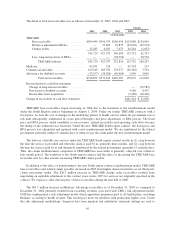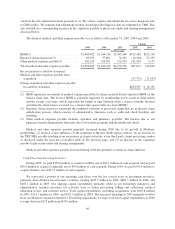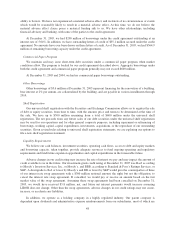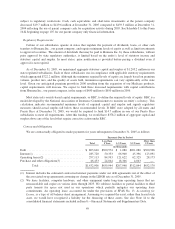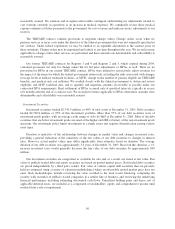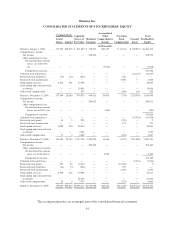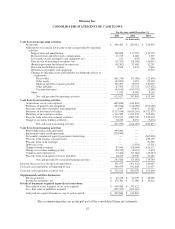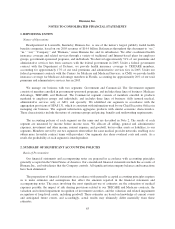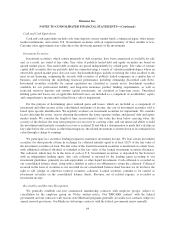Humana 2005 Annual Report Download - page 65
Download and view the complete annual report
Please find page 65 of the 2005 Humana annual report below. You can navigate through the pages in the report by either clicking on the pages listed below, or by using the keyword search tool below to find specific information within the annual report.The CMS risk adjustment model pays more for members with predictably higher costs, as more fully
described on page 5. Under this risk adjustment methodology, diagnosis data from inpatient and ambulatory
treatment settings are used to calculate the risk adjusted premium payment to us. We collect, capture, and submit
the necessary diagnosis data to CMS within prescribed deadlines. We estimate risk adjustment revenues based
upon the diagnosis data submitted to CMS and ultimately accepted by CMS.
CMS is transitioning to the risk adjustment model while the old demographic model is phased out. The
demographic model based the monthly premiums paid to health plans on factors such as age, sex and disability
status. The monthly premium amount for each member is separately determined under both the risk adjustment
and demographic model. These separate payment amounts are then blended according to the transition schedule.
CMS is transitioning to the risk adjustment model for Medicare Advantage plans as follows: 50% in 2005, 75%
in 2006 and 100% in 2007. The PDP payment methodology is based 100% on the risk adjustment model
beginning in 2006. As a result of this process and the phasing in of the risk adjustment model, as well as budget
neutrality as described on page 5, our CMS monthly premium payments per member may change materially,
either favorably or unfavorably.
Premium revenues and ASO fees are estimated by multiplying the membership covered under the various
contracts by the contractual rates. In addition, we adjust revenues for estimated changes in an employer’s
enrollment and customers that ultimately may fail to pay. Enrollment changes not yet reported by an employer
group, an individual, or the government, also known as retroactive membership adjustments, are estimated based
on historical trends. We monitor the collectibility of specific accounts, the aging of receivables, as well as
prevailing and anticipated economic conditions, and reflect any required adjustments in the current period’s
revenue.
We bill and collect premium and ASO fee remittances from employer groups, the federal and state
governments, and individual Medicare Advantage members monthly. Premium and ASO fee receivables are
presented net of allowances for estimated uncollectible accounts and retroactive membership adjustments.
Premiums and ASO fees received prior to the period members are entitled to receive services are recorded as
unearned revenues.
TRICARE Contract
In 2005, TRICARE revenues represented 17% of total premiums and administrative services fees. The
single TRICARE contract for the South Region includes multiple revenue generating activities and as such was
evaluated under Emerging Issues Task Force (EITF) Issue No. 00-21, Accounting for Revenue Arrangements
with Multiple Deliverables. We allocate the consideration to the various components based on the relative fair
values of the components. TRICARE revenues consist generally of (1) an insurance premium for assuming
underwriting risk for the cost of civilian health care services delivered to eligible beneficiaries; (2) health care
services provided to beneficiaries which are in turn reimbursed by the federal government; and (3) administrative
service fees related to claim processing, customer service, enrollment, disease management and other services.
We recognize the insurance premium as revenue ratably over the period coverage is provided. Health care
services reimbursements are recognized as revenue in the period health care services are provided.
Administrative service fees are recognized as revenue in the period services are performed.
The TRICARE contract contains provisions whereby the federal government bears a substantial portion of
the risk associated with financing the cost of health benefits. Annually, we negotiate a target health care cost
amount, or target cost, with the federal government and determine an underwriting fee. Any variance from the
target cost is shared. We earn more revenue or incur additional costs based on the variance in actual health care
costs versus the negotiated target cost. We receive 20% for any cost underrun, subject to a ceiling that limits the
underwriting profit to 10% of the target cost. We pay 20% for any cost overrun, subject to a floor that limits the
underwriting loss to negative 4% of the target cost. A final settlement occurs 12 to 18 months after the end of
each contract year to which it applies. We defer the recognition of any revenues for favorable contingent
underwriting fee adjustments related to cost underruns until the amount is determinable and the collectibility is
55


